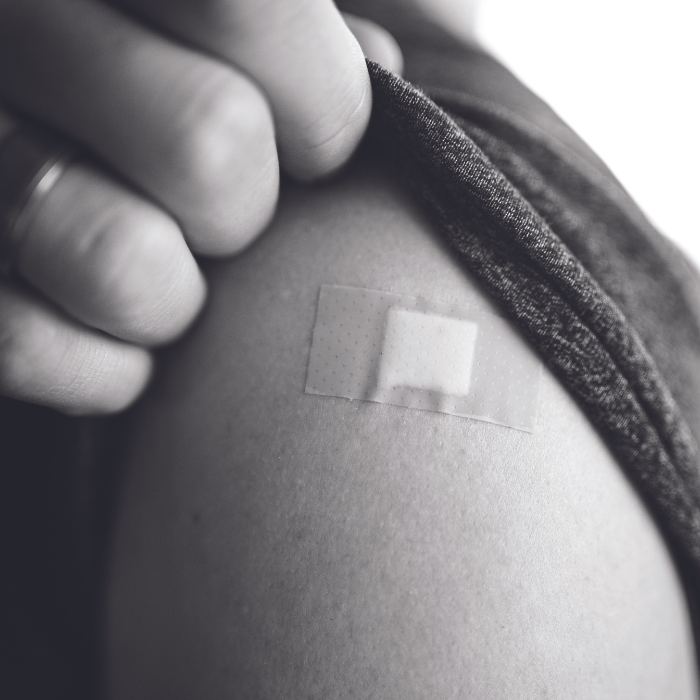
While our body manufactures its own vitamin D from natural sunlight, how can we ensure we get enough of this important vitamin during the winter months?
why do we need it?
The major function of vitamin D is to help our bodies absorb calcium from the food we eat. Most people already know that dairy products and other foods rich in calcium are essential for developing and maintaining strong bones. However, optimal bone health requires adequate calcium and vitamin D in your diet. This is because while calcium is a vital bone-building material protecting against osteoporosis, it cannot do its job without adequate vitamin D. Osteoporosis is a condition in which the skeleton loses bone mass and minerals, and bones become more porous, thinner and weaker, leading to an increased risk of a fracture.
Vitamin D is the only vitamin that we don’t need to take in via our diet. Although it occurs naturally in small amounts in some foods, diet is not our main source of this vitamin. Indeed, vitamin D can be “manufactured” by the action of sunlight on the skin and, as a result, is sometimes referred to as the “sunshine vitamin”. As vitamin D is not present in significant amounts in many foods, sunlight exposure is in fact our most important source of this vitamin. For most people, 90% of
their vitamin D requirement comes from the action
of sunlight.
Vitamin D was first identified as being an essential nutrient when it was discovered children given cod liver oil, which is high in vitamin D, did not develop rickets (early age bone deformities). Later, it was found that exposure to sunlight had a similar effect. For those confined indoors, fortified breakfast cereals and oily fish, for example, are a good way to meet their needs
in vitamin D.
how much do we need?
Exactly how much vitamin D is obtained from the ultraviolet light in sunlight, and therefore how much sun exposure is needed each day, depends on various factors including skin pigmentation (darker skin needs more UV to produce vitamin D) and coverage by clothing and sunscreen. Environmental factors such
as the angle of the sun, distance from the equator
and the amount of cloud also affect the amount of vitamin D produced (the less intense the sun, the
more is needed).
consequently, individuals at risk for vitamin D deficiency include:
- Darker skinned people.
- People whose skin is largely always covered for religious or cultural reasons.
- Older adults who are housebound or in residential care and who do not get enough sunlight exposure (if they are not taking vitamin D supplements).
- Infants exclusively breastfed beyond six months and without sunlight exposure and vitamin D supplementation (breast milk, while on the whole very beneficial for the baby, can be a poor source
of vitamin D particularly if the mother is
vitamin D deficient).
Sunlight is needed for adequate vitamin D and children should be encouraged to play outside all year round. However, between early October and late March, when ultraviolet light levels are high in New Zealand, most children will get sufficient vitamin D if playing outdoors for just 10-15 minutes either side of the peak sun hours (11am to 4pm) and it is not advisable to deliberately seek sun exposure during peak sun times.
Vitamin D deficiency in children can lead to rickets, while a deficiency during pregnancy and extreme protection of children from sunlight are believed to cause the same. In adults, vitamin D deficiency can lead to weakness and pain. However, in excess, vitamin D can produce kidney damage by causing excess calcium to be deposited in the organs.
The adequate vitamin D intake for most healthy people from infants to adults up to 50 years old, including pregnant and breastfeeding women, is 5 micrograms per day. Adults between 51 and 70 years old should increase their intake to 10 micrograms per day. Adults over 71 years old need a higher intake of 15 micrograms per day.
what foods can we get it from?
Some of the foods that are good sources vitamin D include:
- Cod liver oil
- Salmon
- Herring fillet
- Sardines
- Tuna
- Rainbow trout
- Mackerel fillet
- Eggs
- Fortified breakfast cereals
- Fortified margarine and dairy produce
Available year-round, fish is a wonderful substitute for meat protein. Its versatility and the large variety on offer make it easily adaptable to all methods of cooking, whether in soups, salads, stews or
baked dishes.
Remove any bones when serving fish to children, as they are the most common food to obstruct the airway and cause choking. Some fish – such as tuna, salmon, sardines and mackerel – is available canned and is a definite pantry must-have to take along on a picnic or to use when you run out of fresh fish.
I used to make this canned fish pasta recipe when we went camping because it uses dehydrated vegetables, canned fish and tomato sauce which makes it such a convenient dish. You can vary the kind of tomato sauce you use, depending on your taste and what you have on hand.
Canned fish pasta
Serves 6
Ingredients
- 1 × 220g tin chunky tuna flesh in brine
- 1 × 125g tin sardines in oil
- 1 × 105g tin salmon in brine
- 1 × 100g packet dehydrated vegetables
- 375g large shell pasta
- 2 tablespoons oil
- 1 × 750g tomato sauce of your choice
- 100g cheese, grated
- salt and pepper
Directions
Place the dehydrated vegetables in a saucepan half-filled with water and bring to the boil. Simmer for 10 minutes and drain.
Cook the pasta al dente in a large saucepan filled with salted boiling water according to the packet instructions. Drain and transfer to a large wok along with the vegetables. Mix in the oil.
Drain and crumble the canned fish fillets, discarding any bones. Add to the pasta, along with the tomato sauce. Mix well. Sprinkle with the grated cheese and season with salt and pepper. Cook over a medium heat, stirring occasionally until the dish is piping hot and the cheese is melted. Serve immediately.
Christelle Le Ru is a Cookbook author & mum of four www.christelle-leru.com.








